Japanese Spitz
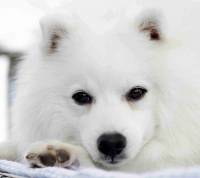 Japanese Spitz
Japanese Spitz
A medium sized white dog, the Japanese Spitz developed as a pure breed during the 1900's. He comes in only one size and although usually a companion or pet dog, he also makes an excellent watchdog.
History of the Japanese Spitz
Two alternative theories are argued:
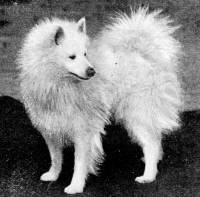 White Spitz c 1900
White Spitz c 1900
The first is that the Japanese Spitz is a direct descendant of the herding and sled dog, the Samoyed. This theory is a result of them originally being called called 'Samo' like their larger relative. Certainly it is probable that these two breeds had a common background centuries ago. But in addition to the difference in body proportions and function, this theory has no documented evidence.
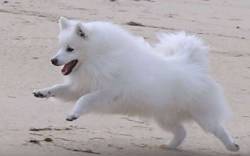 The Japanese Spitz Today
The Japanese Spitz Today
The second is that the Japanese Spitz was created from and developed in Japan by expert cynologists between 1920 and 1950 from the large sized white German Spitz. This theory purports several lines of white German Spitz were imported into Japan from Russia and China. However, there is no documented evidence about either these imports or the pedigrees of the Japanese Spitz that were supposedly exhibited at a Tokyo Dog show in 1921.
The Japanese Spitz becomes Pure Breed
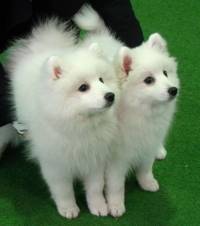 Japanese Spitz pups
Japanese Spitz pups
Because of consistency of pedigree records kept by the Nippon Spitz Association (NCA), it is generally accepted that they founded the modern Japanese Spitz. The NCA has documents to support that the Japanese Spitz descends from early white Spitz that came aboard a rescue cargo-ship from Canada following an earthquake in Tokyo in 1923. The NCA also has records to prove that similar dogs from America followed.
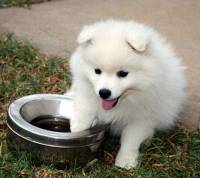 Japanese Spitz Baby
Japanese Spitz Baby
Jiro Ito meticulously kept these records in Tsuchiura, Ibaragi Perfecture, north-east of Tokyo[1] right through the Second World War until the Japanese Kennel Club recognised the breed in 1947 and adopted the Breed Standard in 1953.
In 1973 the first exports from Japan arrived in Sweden who recognised the Japanese Spitz as a pure breed by 1976. In 1977, these Swedish dogs founded the breed in UK. Despite England also importing directly from Japan in 1980, it would be 1988 before Challenge Certificates were awarded.[2]
History of Japanese Spitz in Australia
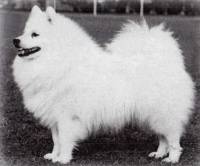 Owlcotes Snow Quest (UK)
Owlcotes Snow Quest (UK)
Meanwhile the first two imports into Australia came from UK in 1979 - 1980. These were Ch Norsken Amida and Ch Norsken Diabutsu. These were followed by Ch Kaipoi Count Passola, bred in New Zealand from UK imports. Other UK imports followed including Owlcotes Snow Quest who was an early Best in Show winner. After these initial successes, in 1985 Lacebark kennels was established in Victoria and has piloted the breed in this country ever since [3].
The Japanese Spitz Today
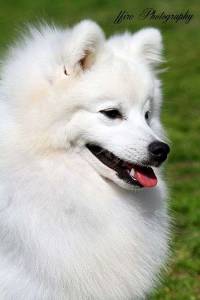 Japanese Spitz
Japanese Spitz
As his name suggests, this typical white Spitz breed stands 30 - 37 cm tall (12 - 14.5 ins) and has a height-length body ratio ratio of 10:11
The wedge-shaped, moderately broad head is of medium size without coarseness. The slightly rounded skull is broadest at occiput. The stop is well defined. The muzzle should be in proportion to the head with black firm, tight lips and a small, black, nose and closes is a normal scissors bite. The dark oval eyes are of moderate size and set rather obliquely but and not too wide apart. The eye rims are black.The triangular ears are high set and stand erect, facing forward but not too wide apart.
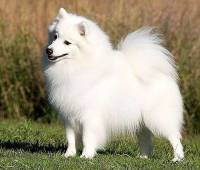 Japanese Spitz
Japanese Spitz
The strong neck is arched and of moderate length. The body is longer than height at withers and the back is short, straight and flexible. The loins broad and firm with a level croup and high set tail.
 Japanese Spitz
Japanese Spitz
The well-cushioned feet are small round and cat-like, with black pads and preferably dark nails. The chest is broad and deep, the ribs are well sprung and the belly firm with moderate tuck-up.The well proportioned muscular hindquarters moderately angulated with hind legs parallel to each other when viewed from rear. The moderate length, well plumbed tail is high set and carried curved over the back.
 Japanese Spitz
Japanese Spitz
He moves with a light, nimble, active, energetic but smooth gait. The pure white coat is shorter on face, ears, front of fore and hind legs and below the hocks. The remainder of body coat is a long double coat consisting of a straight and stand-off outer coat and a profuse, short, dense undercoat which is soft in texture. The mane on neck and shoulders should reach down to the brisket and the tail should be profusely covered with long hair.
Comparison between Pomeranian, German Spitz and Japanese Spitz
As stated above, the Japanese Spitz became known outside Japan in during the late 1970s. Being roughly the same size as the German Spitz (Mittel) which was recognized by 1985, there was confusion between these two breeds. This was exacerbated when several German Spitz were imported into the U.K in an attempt to resurrect colours previously lost to the Pomeranian, particularly white. Today, some Pomeranians still have German Spitz in their pedigrees. To assist in recognizing the correct breed type of these breeds, the table below has been constructed.
| Pomeranian | German Spitz (Mittel) and (Klein) | Japanese Spitz | |
|---|---|---|---|
| Country of Development | Britain |
Germany |
Japan |
| Size | Weight:1.8 - 2.2 kgs (4-5.5 lbs) |
Height:Klein 23-29cms (9-11.5 ins) Mittel 30-38cms (12-15 ins)
|
Height: 30 - 37 cm (12 - 14.5 ins) |
 Pomeranian Pomeranian |
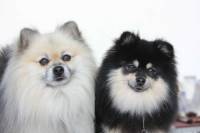 German Spitz (Klein) German Spitz (Klein) |
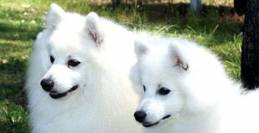 Japanese Spitz Japanese Spitz |
|
| Skull:muzzle ratio | Slightly shorter in muzzle than length of skull. | Length of skull and muzzle equal. | Muzzle should be in proportion to the head |
| Ears | Small triangular shaped erect ears often so small they are hidden by the ruff. | Triangular shaped erect ears that are set high on the head, are a little larger so they will always be visible. | The triangular shaped ears are high set and facing forward but not too wide apart. |
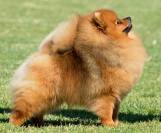 Pomeranian Pomeranian |
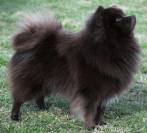 German Spitz (Klein) German Spitz (Klein) |
 Japanese Spitz Japanese Spitz |
|
| Body Length | Body is short and compact | Length from point of shoulder to point of buttock equal to height at withers | Height to body length is in the ratio of 10:11 |
| Tail | The Pomeranian is the only Spitz breed whose heavily plumed tail lies flat and straight up his back, with his buttocks behind the tail-set. | The German Spitz's tail curls over the back and is carried to one side or curls into a ring shape. | The Japanese Spitz's tail is well plumed, high set, of moderate length and carried curved over the back. |
 Pomeranian Pomeranian |
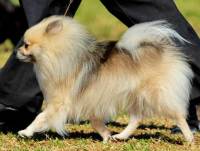 German Spitz (Klein) German Spitz (Klein) |
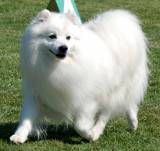 Japanese Spitz Japanese Spitz |
|
| Coat | The Pomeranian's abundant double coat may be trimmed for the show-ring. | German Spitz's double coat should not be trimmed except for the legs beneath the hocks, the anal area and the feet. | The pure white coat has a straight and stand-off outer coat and a profuse, short, dense undercoat which is soft in texture. |
| Colour | All whole colours permissible including parti-colours. Whites must be quite free from lemon or any other colour. | The German Spitz comes in comes in all colour varieties, except merle. | Pure white only. |
Today, the major differences between these three breeds are:
- The Japanese Spitz has a height of 30-37 cm (12-14.5 ins) similar to the German Spitz (Mittel) 30-38cms (12-15 ins), the height size of the Klein measuring 23-29cms (9-11.5 ins) from withers to ground. The Pomeranian should weigh should be 1.8 - 2.2 kgs (4-5.5 lbs)
- The Pomeranian has a skull-muzzle ratio of 3:1 or 3:2 with a deeper stop than the German Spitz whose skull:muzzle ratio is roughly equal. The Japanese Spitz is slightly longer again in muzzle.
- The Pomeranian's skull is not as flat as the German Spitz or Japanese Spitz whose heads are shaped more like a broad wedge.
- The Pomeranian's small triangular shaped erect ears are often so small they are hidden by the ruff, especially if the coat is abundant. In contrast the German and Japanese Spitz's triangular shaped erect ears that are also set high on the head, are a little larger so they will always be visible.
- The Pomeranian appears shorter in body than the German Spitz but both are much shorter than the Japanese Spitz whose body length is in the ratio of 10:11. This enables the Japanese Spitz to have longer stride than the other two breeds considered here.
- The Pomeranian is the only Spitz breed whose heavily plumed tail lies flat and straight up his back, with his buttocks behind the tail-set. In contrast the German Spitz's tail curls over the back and is carried to one side or curls into a ring shape and the Japanese Spitz's tail just curls over the back.
- The Pomeranian's abundant coat may be trimmed for the show-ring. But neither the German Spitz nor the Japanese should trimmed except for the legs beneath the hocks, the anal area and the feet. When seen in silhouette, neither the German Spitz nor the Japanese Spitz should have so much coat that they resemble the Pomeranian.
References and Further Reading
[1] Marco G Piasentin 'The Japanese Spitz', Self-published by Zeilo Edizioni, Padua Italy ISBN 88-85689-16-7 Chapter 2 'Origins of the Japanese Spitz Pages 2 - 19
[2] Michael P Rule, 'Japanese Spitz', Published by Kennel Club Books, Inc Allenhurst USA ISBN 1-59378-360-4 'History of the Japanese Spitz' Pages 9 - 16
[3] Amanda Huggins 'Japanese Spitz History in Australia' Published by 'National Dog' the Ringleader Way, (Published by Sahjobe Pty Ltd, Menangle Park NSW ABN 86 075 412 761) November 2009 The Professional Edition Breed Feature Volume 12 Number 11 Page 9.